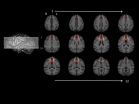(Press-News.org) ATLANTA--The ability to delay gratification in chimpanzees is linked to how specific structures of the brain are connected and communicate with each other, according to researchers at Georgia State University and Kennesaw State University.
Their findings were published June 3 in the Proceedings of the Royal Society B: Biological Sciences.
This study provides the first evidence in primates, including humans, of an association between delay of gratification performance and white matter connectivity between the caudate and the dorsal prefrontal cortex in the right hemisphere, said Dr. Robert Latzman, assistant professor in the Department of Psychology at Georgia State, who led the study with Dr. William Hopkins, professor of neuroscience at Georgia State.
The researchers found higher white matter connectivity between the caudate and dorsal prefrontal cortex in the right hemisphere of the brain was associated with the learning of delay of gratification.
Delay of gratification, the need to control emotional and behavioral impulses, is one of the earliest demands placed on individuals and is of critical importance, Latzman said.
"Delay of gratification or self-control is core to a number of different types of mental illnesses, most notably ADHD (attention deficit/hyperactivity disorder)," said Latzman. "This ability and the developmental process that occurs when children learn to delay gratification and inhibit an immediate want for a longer-term goal is a hugely important developmental milestone."
There is a considerable need for understanding connections among brain regions associated with delay of gratification abilities, such as the two regions that showed significant results in this study, Latzman said.
The task used to measure delay of gratification in chimpanzees in this study is a parallel task to that used in a series of famous experiments conducted by psychologist Walter Mischel at Stanford University in the 1960s and 1970s. Preschoolers were placed alone in a room furnished with a small desk and on the desk were two marshmallows and a bell. The researcher told the child he had to leave the room, but when he returned, the child could eat both marshmallows. If the child wanted to eat one marshmallow before the researcher returned, the child could ring the bell and eat one, but not both. When the researcher shut the door, some children ate the marshmallow right away and others tried to distract themselves, according to The New York Times.
In follow-up studies, Mischel found that delay of gratification abilities at age 4 can predict a number of behaviors into adolescence and adulthood, including planning and reasoning abilities, control of negative emotions, standardized test scores, higher educational attainment, better coping abilities, fewer interpersonal difficulties, less substance use and higher self-esteem and self-worth more than 20 years later, according to Latzman.
The current study involved 49 chimpanzees that were trained to perform a delay of gratification task. Researchers placed grapes in a transparent PVC pipe with a closed bottom and trained the chimpanzees to delay gratification in receiving the grapes. The study used chimpanzees because their self-control abilities, as compared to other model species such as monkeys, closely resemble those of human children and both their neuroanatomy and neural development are quite similar to humans. They also share a very high degree of genetic overlap, Latzman said.
"We trained them to learn that if they waited, the one grape becomes two grapes and two grapes become three grapes and three grapes become four grapes and so on. There's variability in how well they do and it was this variability that we were interested in," Latzman said.
All chimpanzees received DTI (diffusion tensor imaging) brain scans during their annual physical examination. Data were acquired that allowed the researchers to examine white matter tracts, or bundles of neurons that connect one part of the nervous system with another, between the caudate and prefrontal cortex. The white matter connectivity between these brain structures was compared to the chimpanzees' delay of gratification abilities.
INFORMATION:
The research team also included Dr. Jared Taglialatela of Kennesaw State.
The study is supported by the National Institutes of Health.
A tougher federal standard for ozone pollution, under consideration to improve public health, would ramp up the importance of scientific measurements and models, according to a new commentary published in the June 5 edition of Science by researchers at NOAA and its cooperative institute at the University of Colorado Boulder.
The commentary, led by Owen Cooper of the Cooperative Institute for Research in Environmental Sciences and NOAA's Earth System Research Laboratory, looks at how a new, stricter ozone standard would pose challenges for air quality managers at state ...
Modern mountain climbers typically carry tanks of oxygen to help them reach the summit. It's the combination of physical exertion and lack of oxygen at high altitudes that creates one of the biggest challenges for mountaineers.
University of Washington researchers and collaborators have found that the same principle will apply to marine species under global warming. The warmer water temperatures will speed up the animals' metabolic need for oxygen, as also happens during exercise, but the warmer water will hold less of the oxygen needed to fuel their bodies, similar to ...
If you want to live, you need to breathe and muster enough energy to move, find nourishment and reproduce. This basic tenet is just as valid for us human beings as it is for the animals inhabiting our oceans. Unfortunately, most marine animals will find it harder to satisfy these criteria, which are vital to their survival, in the future. That was the key message of a new study recently published in the journal Science, in which American and German biologists defined the first universal principle on the combined effects of ocean warming and oxygen loss on the productivity ...
From a single drop of blood, researchers can now simultaneously test for more than 1,000 different strains of viruses that currently or have previously infected a person. Using a new method known as VirScan, researchers from Brigham and Women's Hospital (BWH) and Harvard Medical School tested for evidence of past viral infections, detecting on average 10 viral species per person. The new work sheds light on the interplay between a person's immunity and the human virome -- the vast array of viruses that can infect humans - with implications both for the clinic and for the ...
PHILADELPHIA - Around-the-clock rhythms guide nearly all physiological processes in animals and plants. Each cell in the body contains special proteins that act on one another in interlocking feedback loops to generate near-24 hour oscillations called circadian rhythms. These dictate behaviors controlled by the brain, such as sleeping and eating, as well as metabolic, hormonal, and other rhythms that are intrinsic to the organs of the body. For example, when you eat may have affects on rhythms controlling fat or sugar metabolism, illustrating how circadian and metabolic ...
This news release is available in Japanese.
An analysis using updated global surface temperature data disputes the existence of a 21st century global warming slowdown described in studies including the latest Intergovernmental Panel on Climate Change (IPCC) assessment. The new analysis suggests no discernable decrease in the rate of warming between the second half of the 20th century, a period marked by manmade warming, and the first fifteen years of the 21st century, a period dubbed a global warming "hiatus." Numerous studies have been done to explain the possible ...
This news release is available in Japanese.
Many species are migrating toward Earth's poles in response to climate change, and their habitats are shrinking in the process, researchers say. Two new reports focusing on marine organisms, which have been moving pole-ward at higher rates than terrestrial creatures, show how factors, including those not directly related to climate change, are limiting the ranges of corals and fish. Paul Muir and colleagues investigated 104 species of reef corals -- collectively known as the staghorn corals -- and confirmed the hypothesis ...
This news release is available in Japanese. With less than a drop of blood, a new technology called VirScan can identify all of the viruses that individuals have been exposed to over the course of their lives. Researchers used the screening technique with 569 people from around the world and found that, on average, their participants had been exposed to about 10 viral species over their lifetimes. VirScan provides a powerful and inexpensive tool for studying interactions between the human virome -- the collection of viruses known to infect humans, some of which don't ...
This news release is available in Japanese. Some of the world's last isolated tribes are emerging from the Amazon rainforest, forcing scientists and policymakers in South America to reconsider their policies regarding contact with such people. In this special package of news, Science correspondents Andrew Lawler and Heather Pringle report from Peru and Brazil, respectively -- two countries that are dealing with a spate of first encounters. Lawler describes contact between isolated tribespeople emerging from the forest and indigenous Peruvian villagers, who themselves ...
New technology developed by Howard Hughes Medical Institute (HHMI) researchers makes it possible to test for current and past infections with any known human virus by analyzing a single drop of a person's blood. The method, called VirScan, is an efficient alternative to existing diagnostics that test for specific viruses one at a time.
With VirScan, scientists can run a single test to determine which viruses have infected an individual, rather than limiting their analysis to particular viruses. That unbiased approach could uncover unexpected factors affecting individual ...



